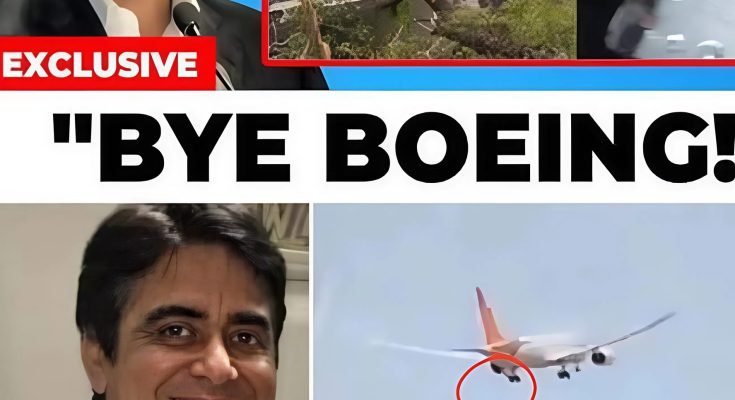For weeks, the world was told the crash of Air India Flight 171 was a tragic but straightforward case: a mechanical failure, a fire, a rapid loss of control. Official statements leaned on the idea that nothing could have been done. But behind closed doors, investigators were uncovering a detail so small it almost escaped notice — and yet so powerful it could rewrite the entire story.
It wasn’t a new piece of debris, nor a missing maintenance record. It was a hand gesture.
The Hidden Recording No One Was Supposed to See
Airbus A321 aircraft like the one used for Flight 171 are not required by international law to have cockpit-facing cameras. But Air India, as part of a safety pilot monitoring trial, had installed them in select planes. The footage is automatically stored with strict access controls, reviewed only if investigators find discrepancies between the Flight Data Recorder (FDR) and Cockpit Voice Recorder (CVR).
For two weeks, no one thought the video would matter. Then, in the dimly lit review room of India’s Directorate General of Civil Aviation, a safety analyst froze the footage at T minus 2 minutes 14 seconds before impact. There it was: the co-pilot, his left hand raised in a sharp, deliberate motion.
At first glance, it looked like a routine signal. But when synced with throttle position readings, the gesture’s implications became chilling.
A Signal Meant for Clarity — or a Fatal Misinterpretation?
Pilots are trained to communicate verbally, especially in emergencies. But when alarms are blaring, oxygen masks are on, and engine noise is deafening, non-verbal cues — like pointing or hand signals — become critical.
According to two investigators who spoke under condition of anonymity, the co-pilot’s gesture resembled the cut-off signal used to indicate that an engine should be shut down. Seconds later, the data shows one engine’s thrust suddenly dropping to idle — but not the one showing signs of fire.
If the camera is interpreted correctly, this could mean that in the chaos of a cascading systems failure, the crew shut down the wrong engine.
Reconstructing the Final Minutes
Based on preliminary analysis, here’s what experts now believe might have happened:
-
Warning Triggered – An engine fire light illuminated in the cockpit.
-
Gesture Given – The co-pilot, believing the fire was in the right engine, made the cut-off gesture toward the corresponding throttle.
-
Throttle Movement – The captain, perhaps misreading the gesture or confirming it without verbal exchange, pulled back the left engine’s control lever instead.
-
Rapid Asymmetry – The aircraft lost thrust on the good engine while the failing engine continued to deteriorate.
-
Control Loss – Asymmetrical thrust and structural damage led to an unrecoverable spiral, ending in the fireball caught by ground witnesses.
This version of events is now being treated as a hybrid failure — mechanical fault compounded by human error, made possible by a split-second miscommunication.

The Human Factor That Haunts Aviation
Captain Anil Mehra, a retired Air India training instructor, explains why this matters:
“We drill procedures for engine failure, but stress changes everything. You have alarms, smoke, vibration, and a clock ticking in your head. If a gesture replaces a checklist, there’s no confirmation loop — and one wrong move can end 200 lives in less than a minute.”
In other words, the gesture was not the problem in itself — the problem was the absence of redundant verbal confirmation in a moment when both pilots thought they understood each other.
Families Confront a New Kind of Grief
When initial reports blamed only the aircraft’s mechanical failure, families found some comfort in believing the pilots had done everything humanly possible. The new revelation is far harder to process.
One widow, whose husband was seated in row 18, described her pain to local media:
“If the wrong engine was shut down, it means they could have had more time… maybe even a chance. Now, I have to live with the thought that my husband’s last moments were shaped by a misunderstanding.”
Aviation’s Silent Debate: Should Cockpit Cameras Be Standard?
International aviation bodies have long debated cockpit video recording. Proponents argue it provides unmatched clarity in accident reconstruction. Opponents cite privacy concerns, crew distrust, and fear of footage leaks.
But after Air India 171, the question isn’t whether cockpit cameras are useful — it’s whether not having them could mean missing the truth entirely.
One senior investigator put it bluntly:
“If we hadn’t had that camera, we’d still be saying it was a pure mechanical failure. The truth would have been buried in the wreckage.”
Where the Investigation Stands
The footage remains classified and will not be released publicly. The DGCA has requested a full simulation of the flight’s final two minutes to test the theory of the misinterpreted gesture. Airbus has been asked to provide data on whether the shutdown sequence matches typical engine fire drills.
In the meantime, airlines worldwide are quietly reviewing their non-verbal emergency protocols, and some are considering banning non-standard gestures in multi-crew operations altogether.




